STEVE AND LISA VASQUEZ
- Details
- Category: Featured Resident
- Published on Tuesday, 16 August 2016 16:15
- Written by D.V. Lawrence
TNN: How long have you been married?
Lisa:Thirty-one years.
TNN: What drew you to each other when you first met?
Steve:Lisa was beautiful and she still is, just a beautiful woman, and just a great spirit. Bright, smart, and could talk to anybody.
Lisa:When I met Steve, he was absolutely the handsomest man to me on the plain planet. He was soft-spoken and charming, and hard-working, and from the day I laid eyes on him, I knew he
 was the one. And he was brutally ... no, sweetly honest. Always and still does, want to do the right thing and I love that about him. And he cooks really well.
was the one. And he was brutally ... no, sweetly honest. Always and still does, want to do the right thing and I love that about him. And he cooks really well. Steve:Thank you sweetie.
TNN:You have three kids and what are their ages now?
Lisa:They are all grown up. There is Steve Jr., Anthony and Gabriella.
TNN:You are looking good!! You said you started your activism fifteen years ago. What got you started?
Lisa:We had kids and it was just a natural thing to have your children do community service of any type.
Steve:We were also involved in the neighborhood because neighborhood councils were just starting up. I was the first president of the Mid City Neighborhood Council. It lasted 6 years. Our kids came to meetings, and participated in all the events, clean-ups and things like that. From there, we met a lot of different people from the city, government officials and just continued on with that.
Lisa:But before that we had started Cooking with Gabby.
TNN:Explain to our readers what this is.
Lisa:Cooking with Gabby is a non-profit organization wwith a mission is to educate children, from the earliest possible age, and their families about how to stay healthy. We do obesity prevention, nutrition education.
TNN:Where?
Lisa:All over. Parks, community centers. Now we work with LAUSD and have programs in three schools, a nutrition program and after school program where Steve and [daughter] Gabby go out and teach children kindegarden through five how to eat healthy. We also have a physical activity program in the schools that starts in the morning so our kids start the day with their endorphins up. They have a lot of fun learning how to be active and healthy.
TNN:How did you get this program started?
Steve:When I had a catering business I would pick my daughter Gabby up from school and take her to my kitchen. She would watch me make food and always ask questions. "Why are you doing it this way, dad? Show me." She was five years old. "Show me how to crack an egg," We just started cooking together, and then I came to Lisa and I said, "Lisa, Gabby has all these questions. Let's start a website and teach kids about cooking." Then we saw that there was an issue with obesity in children, and we said, "You know what? Let's do a healthy cooking class.". As Lisa said, we started in parks and now we do our cooking class in classrooms, and auditoriums. It’s normally twenty kids and all the recipes are interactive. We do a lot of different things. We’ll bake. Gabby went to Japan, and she took this sushi class, and she came back and we did rolls. Sushi rolls with all vegetables, all vegetarian. Then we'll do hummus. Pea pesto. Kids loved it. They went bonkers for it. We served that with celery sticks.
TNN:These are recipes or foods that kids don't normally get to try out?
Lisa:Correct. That's the objective. We teach kids that food comes from Africa, South America or Mexico to the United States.
TNN: How did the physical activity get started?
Steve: We figured that there was something missing because there were a lot of children that weren't exercising. They were doing stuff on their computers and staying home, watching TV. I said, "You know what? These kids need to get out. They need to move.” So we put together a dance team with six dancers, and created a road show and went to different parks. The kids would join us and we saw that they loved to dance and get engaged.
Lisa: All of our dance instructors have taught kids at other dance schools. The principals love it.
Steve: So from there, we said, "Let's create a program" and we created the Cooking with Gabby program.
Lisa: We approached the schools many times over the years, but we wound up with an opportunity through a grant we had received from Community Health Councils.
TNN: How many kids are you reaching?
Steve: We do four classes per group of twenty students four days a week. At the different schools. This last year we reached I think a total of eight hundred students between all three schools. I'm Chef Steve to them. The kids get a recipe at the end of the class, take it home, and we get parents who come and say, "I made this recipe over the weekend. It was really good." Some of our parents come and join this class, which is great. We like that.
Lisa: We participate in the open houses so that we get to meet the parents.
TNN: As if this wasn’t enough, you are also producing a movie about homeless youth.
Steve:We made a movie a couple of years ago called "Sugar," about a homeless girl. It was written and directed by our friend Rotimi Rainwater. Our lead was an actresss named Shanae Grimes (from 90210) and she played a character that had PTSD and wound up on the streets. She ended up in Los Angeles, in Venice and Hollywood which is where the kids normally hang out. It’s about how she ends up creating a family with homeless youth, which happens a lot.
TNN:Is that the movie you are doing now?
Steve:No. We screened it in a bunch of different cities, and we asked different organizations that work with homeless youth to come out and bring some of the homeless youth to see the movie. They did, and each time we did a Q&A afterwards the kids were like, "This is exactly how we feel." "How can you help us? What can you do for us?" So we sat down and asked ourselves what we could do to help these kids and decided to do a documentary on homeless youth. We called it "Lost in America,.” Our team went to sixteen different cities to document the youth and the issues they were going through, talk to government officials, city officials, any organization that was working with homeless youth. It was a two-year journey and we just finished the last edits.
Lisa:Our son Steven Jr. was the primary photographer and producer.
Steve: He did a great job. It's going to be a beautiful film. Hopefully we'll get it into a festival so people can see it. Our congress members said that they liked the film because it clarifies the issues.
Steve:Hopefully when people see Lost In America, it will raise awareness and the elected officials will get phone calls because there is so much to be done. Karen Bass was one of our biggest supporters.
TNN:Now…as if this wasn’t enough, you have another great project. H2BLD, right?
Lisa:H2BLD, House 2 House Breakfast, Lunch, and Dinner. TNN: How did that come about?
Lisa: We're very social and love to eat very healthy. We also enjoy in-home experiences, so we thought if AirBnB can do something of that nature, we can do H2BLD. We wanted to find a way for people to enjoy socializing through food, and provide a way for people to build a small business. A shared economy.
TNN: How does it work?
Lisa:People log on to our website, and we have hosts and guests. The host will host a meal, breakfast, lunch, or dinner, in their home, or apartment, or a venue of their choice. If someone is interested in hosting, we go out and vet them to make sure that it's a nice place. We ask them to create a dietary theme and a social theme. That dietary theme may be healthy, vegan, gluten-free, barbecue. The social theme might be Thanksgiving dinner, Caribbean Carnival, Vision Boarding. Then they set the price point, buy the food based on the sign ups and cook it.
TNN: So the guests go on the site, look at the ones they like, and sign up.
Lisa: Yes, exactly. It's been amazing and is growing fast. We have H2BLD's pretty much between northern and southern California now. We've even had one international H2BLD in Spain. We launched in December, and we just seem to be growing. Our app is going to be out in August.
Steve: We have aspiring chefs that will do dinners. People that love to cook. People that have their grandmother's spaghetti recipe that's amazing, and we're going to do that. We have restaurant chefs that want to try out different foods, new foods, that will do something. The other thing that's very important, Dianne, is that we also created this to really get people to start looking at eating organic and non-GMO. We are creating a chain of local farmers and people that produce, meat, things like that, for our hosts to choose from. We have created a network of organic food producers.
TNN: Those are three big projects. How do you find the time?
Lisa:We struggle with time a lot, but we have been very good at divide and conquer.
Check out their websites
CookingWithgabby.org
H2bld.com
Lostinamericafilm.com
HUMMING ALONG
- Details
- Category: Featured Resident
- Published on Thursday, 23 June 2016 16:24
- Written by Dawn Kirkpatrick
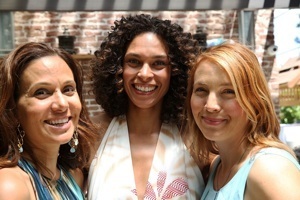
This April, long-time Lafayette Square resident Jennifer Johnson held a benefit luncheon at her home to raise money for her foundation, Hummingbirds, a philanthropic group founded by Johnson and her best friend Cathy Vanderford. It is composed of women and girls interested in promoting the wellbeing of children and women around the globe. According to the Hummingbirds Foundation’s website, the group is “unlike any other nonprofit, where 100% of what is raised goes directly to programs for women and children in need. [Johnson] personally covers all overhead so that every dollar given is used in the field.” This year's luncheon, called Hummingbirds Luncheon for Navajo Reservation, was held to raise money for a water project designed to bring clean, running water to the Navajo Reservation in New Mexico.
Also attending the luncheon was George McGraw, Founder and Executive Director of DIGDEEP, a human rights organization concerned with securing water for all communities in the country. Hummingbirds is partnering with DIGDEEP in its efforts to help the Navajo.
In addition to being provided with lunch, attendees were treated to songs performed by two talented, young Hummingbirds members, MaeLea Williams and Ruby Williams, who sang while playing guitar, keyboard and Ukulele. The afternoon concluded with a raffle of two beautiful Navajo blankets among other prizes.
The week after the luncheon a group of Hummingbirds mothers and daughters went to New Mexico to volunteer and witness the Hummingbirds and DIGDEEP water project in full swing.
According to Johnson in an email, they have raised over $6,000 for their Navajo water project.
Last year, Hummingbirds Foundation raised $21,700 to help fund a project in Cap Haitien, Haiti. The project in Haiti was designed to help move over 200 children to a new community center. “Hummingbirds also raised over $135,000 in funds and equipment to build an outdoor oasis for the children at City Language Immersion Charter (CLIC). CLIC is a public elementary school that serves one of the poorest and most densely populated communities in Los Angeles,” according to the Hummingbirds’ website.
For more information about Hummingbirds Foundation and DIGDEEP, visit:
www.hummingbirdsfoundation.org and www.digdeep.org.
Photo by Dawn Kirkpatrick
JEWEL'S CATCH ONE NIGHTCLUB CLOSING
- Details
- Category: Featured Resident
- Published on Friday, 17 October 2014 17:14
- Written by Chelsee Lowe
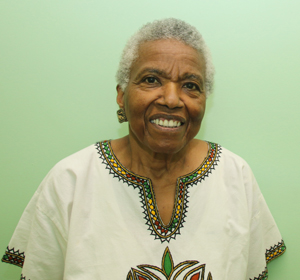
When she opened Jewel’s Catch One nightclub (considered the longest running nightclub in L.A.) in 1973, Thais-Williams motivation was two-fold. As an entrepreneur, she was aiming to start a sustainable business; as an activist, she wanted that business to be a safe venue for fellow members of the gay and lesbian community. Years before she set foot in the Pico Boulevard club, Thais-Williams had worked across the street at a neighborhood market, and the then-owners of the bar were openly discriminatory.
“They made it very clear that they didn’t want black folks in there drinking, and I had this fleeting idea that one day I’d own that place and that everyone would be welcome,” she said. “Needless to say, I didn’t sleep much the night I learned it was for sale.”
The club began as a smaller venue, initially occupying just the first floor of the multi-level 1923 structure. Over time, the bar’s success allowed Thais-Williams to grow the business, until she eventually owned the entire building. The club shined bright during the disco era and beyond, hosting thousands of guests, musicians and actors. Scenes from “Pretty Woman” and “Beaches” were shot there. In Thais-Williams’ mind, she has carried on the tradition of the building. Long before she owned it, Ella Fitzgerald and Nat King Cole were among those who graced its stages.
Thais-Williams has continued to run the club despite an obvious decline in business. Only recently has she considered selling the property — a bittersweet prospect, as she’s worked within its walls for more than 40 years. At the same time, she’s ready to focus on her clinic, the Village Health Foundation.
“The need [for the club] isn’t there anymore,” Thais-Williams said. “The population was gay and lesbian for most of the years — though everybody came, including straight people and stars — but now the community can go anywhere they want to. And now, even when I come out on a Saturday night, no one’s dancing, no one’s talking. They’re all standing on the edge of the room and all you see is white lights, screens.”
Born in 1939 in Geary, Indiana and the fifth of seven children, Thais-Williams says that she has always had an entrepunerial spirit. When she was 9 years old, she started working in her uncle’s corner store in San Diego, where the family had moved after hearing utopian stories of life on the West Coast. She also sites her mother as a driving force in her life.
“My mom was a tyrant,” said Thais-Williams. “Some parents don’t know any better, and my mother was one of them. She’d say, ‘you’re not gonna be nothin’.’ In some instances, that would have worked in the reverse and the kids would have rebelled, but in us she instilled a drive to prove her wrong. We were always over-achievers. We were also afraid that she would kill us if we didn’t succeed.”
Eventually her older siblings landed in Los Angeles. When Thais-Williams was accepted to UCLA in 1957 with a small scholarship from a black sorority, she moved to town and shared a house near Orange Avenue and West Haven Street with her brothers and sisters. But after one year of pre-pharmacy classes, she dropped out.
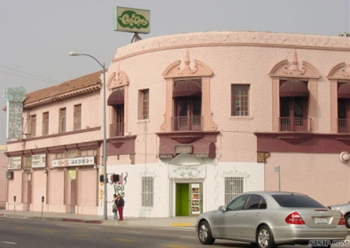
“I couldn’t envision myself counting pills and making cough syrup for the rest of my life,” Thais-Williams said. “I also didn’t have money to continue. But I always had the desire to finish school, mainly because I wasn’t supposed to.”
Thais-Williams tried on a number of hats in the years that followed, jumping from job to job while continuing her education (she eventually graduated from UCLA in 1971 with a BA in History). She worked in retail shops and more markets. Briefly, she was a sheriff at Sybil Brand Institute, the now-defunct women’s prison on Terminal Island, but seeing the same women cycle in and out of the facility was discouraging. One day, she turned in her badge and walked out. Soon after, she went into business for herself for the first time, opening a women’s clothing manufacturing shop with her sister. A recession took its toll, however, and the shop eventually closed. The thought of opening a nightclub — which she thought just might be recession-proof — came not long after that.
Running the club was the first job Thais-Williams kept for longer than a year and a half. She ran the business for more than 25 years before she felt compelled to try something new again.
“At other jobs, I just got bored,” said Thais-Williams. “In the market, I’d memorize prices and check faster than anybody in the world, and bag just as fast. I had to do something to keep my sanity. The bar was different, because something was always changing. I pretty much saw it all in those 25 years. But then I wanted to do something more productive.”
Still inquisitive about health and nutrition, Thais-Williams connected with a friend of friend who was a Jungian psychologist. After meeting with him for some time and explaining her interest in doing something new, the doctor recommended she talk with an acquaintance who was studying acupuncture. Eventually, Thais-Williams enrolled at Samra University of Oriental Medicine, located in neighboring Koreatown. She was in her early 60s and a student once again.
“After one class, I was hooked,” Thais-Williams said. “I hadn’t been to school in 30 years, so I had to study a lot. But I liked it.
Once she earned her acupuncture license, Thais-Williams and Chung Hee Yi, a friend she’d met in school, started working with AIDS patients at a prevention office near La Brea and San Vicente Boulevards. As fate would have it, that office closed around the same time that the building next to Catch One was finally for sale. Thais-Williams had had her eye on it for nearly 20 years when she finally purchased it and opened her own clinic.
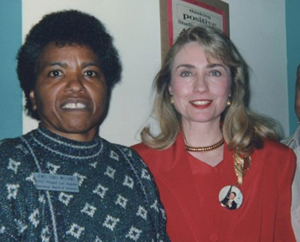
The Village Health Foundation began as three treatment rooms in 2001 but has expanded in size and scope since then. Including Thais-Williams, there are four licensed acupuncturists on staff. Pain management, hypertension, high cholesterol, addiction, allergies and obesity are some of the issues clinic patients are seeking help for. There’s also a mental wellness department and a schedule of health and wellness classes, including yoga and Zumba.
While no one is turned away from treatment at the clinic, the suggested donation for an acupuncture session is $30. There’s also community acupuncture on Saturdays, where the suggested donation is $10. For patients who are unable to pay, Thais-Williams is happy to trade treatment for time volunteered in the clinic.
For years, funds from the bar have helped support the health foundation. Once the club is sold, Thais-Williams will continue her acupuncture practice and, if necessary, use proceeds from the nightclub’s sale to keep the clinic’s doors open.
“We’re starting to make an effort to become more visible. This is what I need to be focused on now.”
For more information about services available at the Village Health Foundation, CLICK HERE or call 323-733-0471
Present Day Photo of Jewel by Dawn Kirkpatrick
Wally Matsuura Life Long Kinney Heights Resident
- Details
- Category: Featured Resident
- Published on Tuesday, 19 April 2016 17:13
- Written by D.V. Lawrence
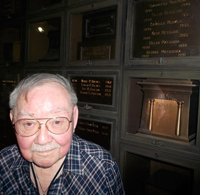 TNN: Wally how long have you lived in this house and how old were you when you moved in?
TNN: Wally how long have you lived in this house and how old were you when you moved in?Wally: Well we moved in, let's say '38 October, so I was about 7, I believe.
TNN: What was the racial mix of the community?
Wally: There was covenant so only people of the Caucasian race could live here. But I think the covenant was coming down already because the Naruse family lived here, they had the big mansion on Gramercy and 25th where the empty lot is and they were Japanese. Then we had the Stanley Uno family who lived on the street that the freeway took which would have been, 22nd or 21st, and they were Japanese. So, the barriers were starting to come down. My mother told the agent to be sure and inform the neighbors that we were of Oriental descent, partially, because she said, if they don't approve of us she didn't want to live here. They approved, so we moved in.
 TNN: Which of your parents was Asian?
TNN: Which of your parents was Asian?Wally: Both. My mother was half Japanese and half German and my father was all Japanese, so I'm three quarters.
TNN: What was it like as a child in this neighborhood?
Wally: Very quiet. All the children who were in the neighborhood had grown. I was going to St. John the Evangelist, south of Slauson and Crenshaw, and then my mother thought it would be easier if I went to 24th Street, so I came out of parochial school and went to a public school, which was just as good because 24th was an excellent school at the time.
TNN: Did you experience any push back for your ethnicity?
Wally: No. A lot of people didn't know I was Oriental because I looked more Caucasian at the time, except for my name of course.
TNN: What did a kid do for fun back then? Were there parks close by?
Wally: First I had a scooter and wagon when we first moved in. Then I got a bicycle so I'd go on my own basically. There was another family, the Winnaman family lived at the northeast corner of 24th and Gramercy, so I hung out some time with them. There were two boys, the father owned a paint store up here on Washington.
TNN: Was this area still considered the outskirts of Downtown?
Wally: No, but it wasn't really mid-city like it is now, it was just a quiet suburb type thing.
TNN: Your parents were very stylish. Did they go out alot?
Wally: Well in the Japanese American community they had quite lavish galas. They used to have big things at the Biltmore and Pasadena Civic where they really dressed.
TNN: Tell me your first memory of your family's experience with internment.
Wally: Well of course, I was still very young. It happened in December 7th 1941, so I would have been 10. My folks said, "They're going to make us get out of here." I don't remember when Roosevelt signed that Executive Order, but we had to leave here by May, 1st 1942.
So it was my mother, father, and my grandfather my mother's father, and me. Then my great-grandmother and my great-aunt stayed here because they were German. We would have lost the house but they kept up the mortgage payments.
TNN: Do you remember your parents reaction to this?
Wally: As far as I can remember there was no great discussion except the fact that we had to prepare to leave.
TNN: So there was no anger or organizing? Just acceptance?
Wally: Yes. The only thing we could take with us was a suitcase with our clothing. For us it worked out all right, but my father's relatives, his sister, brother, mother and father who lived over on Hobart and Olympic and didn't own the house they rented, they lost everything. They had to sell everything quickly. They got $5 for their refrigerator. There were no banks in the concentration camp so people had to take their money and sew it into the hem of their clothes so it wouldn't be stolen. We didn't have that problem because we had the house.
TNN: Okay, so now you're all packed and you're ready to go. What happens? A bus picks you up or ... ?
Wally: First we had to assemble someplace southeast here. Then they had buses to take us to Santa Anita, the racetrack.
TNN: Do you remember what your reaction was or what your parents reaction was?
Wally: No, I frankly don't remember. Except, I did find out from my parents that we were very lucky to be put in a barracks, because some of the earlier arrivals had to live in the stables. They moved the horses out, whitewashed the walls, and moved people in.
TNN: Were the barracks just a big room with lots of beds in it?
Wally: Yeah. 4 beds. Originally when we got there, the barracks were broken into 3 units which was a fairly good size for us. But then they ended up having 18,000 people there so they broke the barracks up, each unit in half again. In the end the only thing that we had room for was 4 army cots, a table in center, a little nightstand and one card table at the foot of the cots.
TNN: Packed like sardines. It sounds like they were unprepared. What about the food?
Wally: There was army style. We had mess halls and we had latrines. The women didn't like it because it was army style. You were right out in the open. We had to take showers in the huge circular horse shower. They split that in half for men and women.
TNN: How long were you there for?
Wally: It was just the assembly center so were there for only 6 months, from May 1st, 1942 until November, sometime in November 1942. We had to stay there the longest because my mother was a dental nurse, so she was in the medical section. My father worked in the administration, so we had to stay until the end. It was almost like a ghost town, most people had left.Then they shipped us to Amache, Colorado. Amache was a permanent center for as long as the war was on from 1942 until the end of the war.
TNN: What was the new place like?
Wally: It was built better, although it was still a barracks. You still went to the latrine, you still went to the mess hall. It snowed, and it got cold, and it was on the edge of the Dust Bowl. We could see the sandstorms coming, the dust storms coming miles away.
TNN: Was that during the big dust storms, and the big drought?
Wally: Well I guess it was the end of it. We were kind of on the edge of what they considered the Dust Bowl, but we got plenty of dust.
TNN: You could see these dust storms coming?
Wally: Yes. The barracks were made fairly well for a winter, not like the Santa Anita barracks, but the dust could just come in everywhere, so after the dust storm the inside of that place was full of dust the same as the outside. Then we had a plague of crickets, and a plague of locusts. We were basically in a desert.
TNN: Were you all packed in again or did you have a little bit more room?
Wally: A little bit more. Let's see, the end unit was for couples, married couples, so those were small because you only needed one bed. They were still cots so I suppose there were 2 cots. Anyway, of course we had 4 of us, so we were in a fair sized room. It wasn't as cramped as Santa Anita, we were able to have a little sitting area. Then of course, we had to have a pot belly coal stove and that. Yeah so it was little bit bigger.
Then my father went into the service in '43. He had to go to language school and learn how to read and write and speak Japanese because he was going to interrogate prisoners.
TNN: So now, they're saying, "We're going to use your dad in the army to help us, but your family still has to stay in the camp"?
Wally: Oh yeah, oh yeah, that happened everywhere. Although Dillon Myer who was the Head of the War Relocation Authority, told my parents that when my father got into the service, that he would get us back to Los Angeles. It took him awhile. My father went in August or September of '43. Then he had an intensive course in Japanese in Fort Snelling. First he was at Camp Savage in Minnesota, then he was transferred to Fort Snelling in Minnesota, where he graduated. But it was an intense 9 months course.
TNN: Meanwhile, leaving his family back at the camp.
Wally: Yeah. Myer got us out in January of 1944 on military permit. I had Western Defense Command ID to allow me to be in California. My mother and I, we had to carry ID with us.
TNN: In case they said, "Hey you're Asian, what are you doing out of the camps?"
Wally: Right.
TNN: Did anybody get angry about any of this?
Wally: Yeah they did, but it wasn't around us, you know. As a matter of fact, my father's brother, they were at Heart Mountain, Wyoming, and he was arrested for protesting and sent to Leavenworth. Of course, he was pardoned after the war, but I mean, that's where he spent some time. There was one guy Korematsu or something like that, he was a big guy protesting the fact that we were American citizens and put in a camp. My grandfather of course, could not become a citizen, Orientals could not become citizens. He was always an enemy alien. He understood the situation, and he said that he would be willing to go into a camp, but he didn't think we should go in, but he just said that to us, he didn't go out and protest. So, that's why he was with us all the time. Then he couldn't come back to California, so he went to Chicago.
TNN: Why couldn't he come back to California?
Wally: Because he was Japanese. Japanese could not be in California, Oregon or Washington while the war was still on.
TNN: So it wasn't Japanese from everywhere?
Wally: No, if you lived east, if you lived anywhere east, say you lived in Colorado for instance, you weren't evacuated, only the West Coast.
TNN: In case one of you happened to be an enemy agent?
Wally: Right. I think there were a 110,000 people in camps.
TNN: Now did they ever discover an enemy agent amongst any of you?
Wally: No, not to my knowledge. So we got back in January of '44 like I said, on military permit. - I can't find the card. I’ve had it until recently. My mother, of course she was well known in the dental industry here, so she got a job right away. The army told my mother, not to send me to school until the fall, which was fine with me.
TNN: Did they have school for the kids in the barracks at all?
Wally: Yeah, they had a school, well not so much in Santa Anita because you know, that was only temporary but in Colorado they did. I didn't show up half the time. It wasn't that good a school.
TNN: Now when you came back to the community, what was it like amongst your neighbors?
Wally: Same as when we left.
TNN: Same as always. Did anybody come over say, "Oh I'm so sorry this happened to you?"
Wally: Well I suppose, there were like the Sutherlands, you know, they were pretty good friends with my parents, they were sorry. Then of course, Mr Perkins who lived next door, he died during the war. By the time we came back new people owned the house. So, you know, the rest of the people we didn't know that well.
TNN: When you went back to school did you get any attitude from any of the kids?
Wally: Only once but that wasn't right away. There was a fellow in the next block who started harassing me, and the police went and talked to him. Told him my father had been in the service and all this stuff. Then it was all right. But that was all.
TNN: So it was like, "Okay we have to go to these camps and now we're back," and boom, that was it? No big drama?
Wally: No we just moved back in. Of course it was only my mother and me with my grandparents and my aunt. They were able to keep the house up. We had to sell that Buick. My father had an older Ford, sold that. Then they borrowed on their life insurance and that got us through that period of time as far as ... oh and the finance company even lowered the payments, which was very nice.
 TNN: Now I want to fast forward. On Saturday at 4:30 every Saturday, I've been coming for 3 years faithfully, the neighbors from the block gather at your porch and bring refreshments, and sit and enjoy neighborly conversation and interaction. They have little events in the summer and you know, if one of kids in the neighborhood is getting dressed up for a prom, they have to come over and get approval from everybody, and oohs and aahs. It's just the most charming, sort of community old-school way of being with your neighbors, and Wally you're at the center of that. How did it start and when?
TNN: Now I want to fast forward. On Saturday at 4:30 every Saturday, I've been coming for 3 years faithfully, the neighbors from the block gather at your porch and bring refreshments, and sit and enjoy neighborly conversation and interaction. They have little events in the summer and you know, if one of kids in the neighborhood is getting dressed up for a prom, they have to come over and get approval from everybody, and oohs and aahs. It's just the most charming, sort of community old-school way of being with your neighbors, and Wally you're at the center of that. How did it start and when?Wally: It started after I retired in '86. It didn't start right away though. First I used to go to the Sutherland house because they would invite me for martinis, they loved to have martinis in the late afternoon. One day, we were over there, and actually we were on the front porch, we used to be in back under the closed in porch . One day we happened to be out on the front porch, and at that time, I didn't know Roy and Shirley. They were having a movie shoot, actually it was television, and so Roy came over and then Amos came over, who lived across the street, That's how we met. But it still didn't start yet until after 1986.
Then I used to have block club meetings here. Louise wanted to start a block club so you had the block club here. Then I got to know Roy and Shirley pretty well, and I don't know how long that took. Then Shirley goes to Mass on Saturday, and Roy is not Catholic, so he started coming over here, and we'd have glass of wine. I said, "Well gosh, that sounds like Shirley's going to Mass and you're coming for communion." That's kind of how it kind of started. We'd talk about different things. Then slowly, other people would come by and it just kind of built from that time. It took years really, because Ron Hutchinson didn't move in here until '91, and it was a long time before Ron started coming over here. It really took a while for it to build up.
TNN: But the secret was everyone showing up every Saturday at that time.
Wally: Yeah, and then people would see us, and then they'd come and talk, then they'd come back. That's basically how it all started.
TNN: Now on a busy porch day, there could be how many people in the neighborhood standing on that porch and yabbering?
Wally: 15, 25 but typically it's about 8 to 10.
TNN: You’re now living alone, you had a room mate here for a long time, so what does this gathering do for you? How does it affect your energy?
Wally: It keeps me going really, you know, it's nice because I know I have all these neighbors, if I need any help all I have to do is call.
TNN: It keeps you healthy and feeling supported. The value of having neighbors you are connected to and community is so critical for seniors.
Wally: Yeah, that's what's fantastic about this, this block. It's just wonderful. I mean, there's no other way to say it. It's too bad it can't be this way all over. But these people on this block, they're very special, very supportive of each other. Everyone gets along well, and I hope it never changes.
How Conrad Jones is Making a Difference
- Details
- Category: Featured Resident
- Published on Thursday, 14 August 2014 16:00
- Written by Dawn Kirkpatrick
They practice at Queen Anne Park in Mid-City. They travel to events at various recreation centers throughout Los Angeles after being challenged by other teams. They are Mid-City’s Finest, a multi-ethnic basketball team composed of ten 9 and 10-year olds and one 11-year-old - Johnny Alvarado, Deshawn Dow, Paul Estes, Joshua Huezo, Khomani Jones, Paul Kim, Korion Steen, Erick Marquez, Diego Mullins, Michael Rodriguez and Harrison Ward.

Head Coach, Conrad Jones, 32, founded Mid-City’s Finest about a year ago after coaching the adult league at the Park and noticing a number of children playing basketball without a clear sense of some of the fundamentals of playing the game.
“I started the team after coaching some of the players in the younger division. After that I just started searching for all the best players at age 9 and 10 from the Park at Queen Anne,” Jones said. The team is open to both boys and girls. As long as Jones thinks a player has talent, he or she can join the team.
Once Jones, who played basketball growing up, found the best players in the Park, he created Mid-City’s Finest. (Until recently Jones had an assistant coach, William Hylton, who recently moved to Las Vegas.)
Mid-City's Finest is a traveling team and plays at different recreational centers, which like Queen Anne Park have teams composed of their best players.
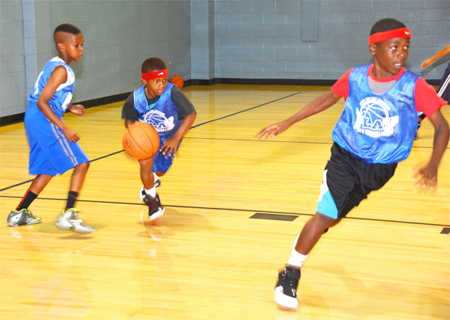
When a team challenges Mid-City’s Finest to a game, Jones, the team and its supporters travel to such recreation centers as Saint Andrews at 8701 S. St Andrews Place and the Jesse Owens Community Regional Park at 9651 S. Western Ave.
After the players arrive at a challenge, Jones puts the team through various practice drills to warm them up for the pending game. After a buzzer sounds, alternating members of the team spend the next two hours or so running up and down the basketball court with seemingly boundless enthusiasm and energy. As they play, Jones shouts out encouraging instructions from the sidelines and at half times gathers the players to give them pep talks.

Players on both the court and sidelines encourage and support each other during games, as well. When a player makes a basket or misses a shot during a free throw, for example, teammates give each other low-fives for encouragement.
Also giving players support are team players’ families and other supporters who travel across the city just to watch the team play.
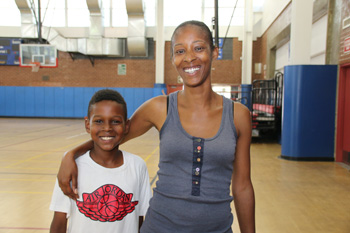
“Wow, it’s an overall good team, good kids," said Ebony Williams, mother of player Khomani Jones. Williams is happy that her son is part of the team and praises the coaching efforts of coach Jones. She marvels at her son’s improvement.
“Coach Jones is beyond amazing with patience. Khomani has improved so much in a year. He’s built up his confidence…. Every single kid is amazing. They adore coach Jones. All come in and greet him. No negative vibes, always embracing and learning. God bless him is all I can say.” To ensure players make it to practice as well as games, the coach even offers anyone a ride to games who doesn't have one, Williams said. "He even brings them Gatorade,” she said chuckling.
Parent Alejandra Marquez, mother of player Erick, also praises coach Jones,“I think he’s really a good coach.” Other coaches scream at players she added. "There’s no screaming, no yelling. Conrad is the best; everything Erick knows Conrad taught him.”
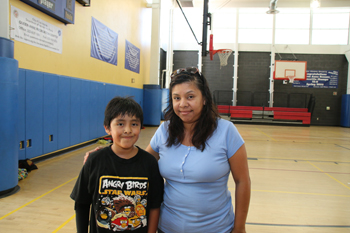
Coach Jones praises the players’ parents in return. He credits their support at practices and games for helping the players thrive.
"Parents travel way to the other parks in packs. More come out to the parks than they actually do for practices and stuff. That’s most important that they’re willing to travel and support the team and the kids."
Jones also hopes to support the team and other children by setting up a nonprofit foundation/organization. “It’s still in the beginning stages. I plan on getting it sponsored and basically have a program system where it’s more than sports.” It will focus on such things as academics. “A couple of students are really good academically, straight A students,” Jones said proudly.
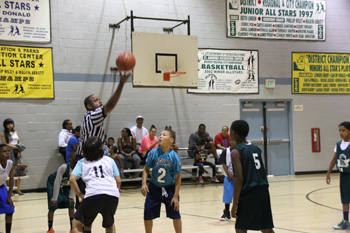 He would also like the nonprofit foundation/organization to focus on “lifestyle needs … health and fitness, various programs that will help [children] with life as they grow up."
He would also like the nonprofit foundation/organization to focus on “lifestyle needs … health and fitness, various programs that will help [children] with life as they grow up."
More Articles...
Today5
Yesterday9
Week14
Month33
All988075
Kubik-Rubik Joomla! Extensions
Yesterday9
Week14
Month33
All988075
Currently are 28 guests and no members online
Kubik-Rubik Joomla! Extensions



